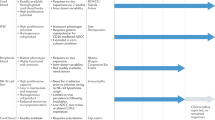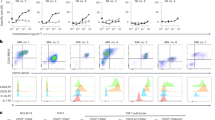Abstract
Here, we report that tumor cells from some patients (23.8%) with Hodgkin lymphoma (HL) are positive for CC chemokine receptor 4 (CCR4). We therefore tested the chimeric anti-CCR4 monoclonal antibody (mAb), KM2760, the Fc region of which is defucosylated to enhance antibody-dependent cellular cytotoxicity (ADCC), as a novel immunotherapy for refractory HL. KM2760 demonstrated a promising antitumor activity in the CCR4-positive HL-bearing mouse model in the therapeutic setting. Although KM2760 did not induce any ADCC mediated by mouse natural killer (NK) cells, it significantly enhanced phagocytosis mediated by mouse monocytes/macrophages against the CCR4-positive HL cell line in vitro. Together with the findings that KM2760 did not exhibit any complement-dependent cytotoxicity or direct antiproliferation activity in vitro, these data indicated that KM2760 exerted its robust in vivo antitumor activity via monocytes/macrophages in mice. In the human system, KM2760 enhanced phagocytic activity mediated by monocytes/macrophages. Furthermore, it induced robust ADCC mediated by NK cells against the CCR4-positive HL cell line in vitro. Thus, it is conceivable that KM2760 would have much more potent antitumor activity in humans than in mice. Collectively, this study strongly indicates that anti-CCR4 mAb could be a novel treatment modality for patients with CCR4-positive HL.
This is a preview of subscription content, access via your institution
Access options
Subscribe to this journal
Receive 12 print issues and online access
$259.00 per year
only $21.58 per issue
Buy this article
- Purchase on Springer Link
- Instant access to full article PDF
Prices may be subject to local taxes which are calculated during checkout




Similar content being viewed by others
References
Bonadonna G, Zucali R, Monfardini S, De Lena M, Uslenghi C . Combination chemotherapy of Hodgkin's disease with adriamycin, bleomycin, vinblastine, and imidazole carboxamide versus MOPP. Cancer 1975; 36: 252–259.
Canellos GP, Anderson JR, Propert KJ, Nissen N, Cooper MR, Henderson ES et al. Chemotherapy of advanced Hodgkin's disease with MOPP, ABVD, or MOPP alternating with ABVD. N Engl J Med 1992; 327: 1478–1484.
Duggan DB, Petroni GR, Johnson JL, Glick JH, Fisher RI, Connors JM et al. Randomized comparison of ABVD and MOPP/ABV hybrid for the treatment of advanced Hodgkin's disease: report of an intergroup trial. J Clin Oncol 2003; 21: 607–614.
Slamon DJ, Leyland-Jones B, Shak S, Fuchs H, Paton V, Bajamonde A et al. Use of chemotherapy plus a monoclonal antibody against HER2 for metastatic breast cancer that overexpresses HER2. N Engl J Med 2001; 344: 783–792.
Coiffier B, Lepage E, Briere J, Herbrecht R, Tilly H, Bouabdallah R et al. CHOP chemotherapy plus rituximab compared with CHOP alone in elderly patients with diffuse large-B-cell lymphoma. N Engl J Med 2002; 346: 235–242.
Hurwitz H, Fehrenbacher L, Novotny W, Cartwright T, Hainsworth J, Heim W et al. Bevacizumab plus irinotecan, fluorouracil, and leucovorin for metastatic colorectal cancer. N Engl J Med 2004; 350: 2335–2342.
Bonner JA, Harari PM, Giralt J, Azarnia N, Shin DM, Cohen RB et al. Radiotherapy plus cetuximab for squamous-cell carcinoma of the head and neck. N Engl J Med 2006; 354: 567–578.
Niwa R, Shoji-Hosaka E, Sakurada M, Shinkawa T, Uchida K, Nakamura K et al. Defucosylated chimeric anti-CCR4 IgG1 with enhanced antibody-dependent cellular cytotoxicity shows potent therapeutic activity to T cell leukemia and lymphoma. Cancer Res 2004; 64: 2127–2133.
Ishida T, Iida S, Akatsuka Y, Ishii T, Miyazaki M, Komatsu H et al. The CC chemokine receptor 4 as a novel-specific molecular target for immunotherapy in adult T-cell leukemia/lymphoma. Clin Cancer Res 2004; 10: 7529–7539.
Niwa R, Sakurada M, Kobayashi Y, Uehara A, Matsushima K, Ueda R et al. Enhanced natural killer cell binding and activation by low-fucose IgG1 antibody results in potent antibody-dependent cellular cytotoxicity induction at lower antigen density. Clin Cancer Res 2005; 11: 2327–2336.
Shinkawa T, Nakamura K, Yamane N, Shoji-Hosaka E, Kanda Y, Sakurada M et al. The absence of fucose but not the presence of galactose or bisecting N-acetylglucosamine of human IgG1 complex-type oligosaccharides shows the critical role of enhancing antibody-dependent cellular cytotoxicity. J Biol Chem 2003; 278: 3466–3473.
Ishida T, Utsunomiya A, Iida S, Inagaki H, Takatsuka Y, Kusumoto S et al. Clinical significance of CCR4 expression in adult T-cell leukemia/lymphoma (ATLL): its close association with skin involvement and unfavorable outcome. Clin Cancer Res 2003; 9: 3625–3634.
Ishida T, Inagaki H, Utsunomiya A, Takatsuka Y, Komatsu H, Iida S et al. CXCR3 and CCR4 expression in T-cell and NK-cell lymphomas with special reference to clinicopathological significance for peripheral T-cell lymphoma, unspecified. Clin Cancer Res 2004; 10: 5494–5500.
Ishida T, Ishii T, Inagaki A, Yano H, Komatsu H, Iida S et al. Specific recruitment of CCR4-positive regulatory T cells in Hodgkin lymphoma fosters immune privilege. Cancer Res 2006; 66: 5716–5722.
Ishida T, Inagaki H, Kusumoto S, Inagaki A, Komatsu H, Iida S et al. CC chemokine receptor 4-positive diffuse large B-cell lymphoma involving the skin: a case report. Int J Hematol 2005; 82: 148–151.
Drexler HG, Gaedicke G, Lok MS, Diehl V, Minowada J . Hodgkin's disease derived cell lines HDLM-2 and L-428: comparison of morphology, immunological and isoenzyme profiles. Leukemia Res 1986; 10: 487–500.
Schaadt M, Fonatsch C, Kirchner H, Diehl V . Establishment of a malignant, Epstein–Barr-virus (EBV)-negative cell-line from the pleura effusion of a patient with Hodgkin's disease. BLUT 1979; 38: 185–190.
Kamesaki H, Fukuhara S, Tatsumi E, Uchino H, Yamabe H, Miwa H et al. Cytochemical, immunologic, chromosomal, and molecular genetic analysis of a novel cell line derived from Hodgkin's disease. Blood 1986; 68: 285–292.
Diehl V, Kirchner HH, Schaadt M, Fonatsch C, Stein H, Gerdes J et al. Hodgkin's disease: establishment and characterization of four in vitro cell lies. J Cancer Res Clin Oncol 1981; 101: 111–124.
Wolf J, Kapp U, Bohlen H, Kornacker M, Schoch C, Stahl B et al. Peripheral blood mononuclear cells of a patient with advanced Hodgkin lymphoma give rise to permanently growing Hodgkin–Reed–Sternberg cells. Blood 1996; 87: 3418–3428.
Stein H, Mann R, Delsol G, Poppema S, Pileri S, Jaffe ES et al. Classical Hodgkin lymphoma. In: Jaffe ES, Harris NL, Stein H, Vardiman JW (eds). Pathology and Genetics Tumors of Haematopoietic and Lymphoid tissues.. IARC Press: Lyon, France, 2001, pp 244–253.
Wallace PK, Kaufman PA, Lewis LD, Keler T, Givan AL, Fisher JL et al. Bispecific antibody-targeted phagocytosis of HER-2/neu expressing tumor cells by myeloid cells activated in vivo. J Immunol Method 2001; 248: 167–182.
van den Berg A, Visser L, Poppema S . High expression of the CC chemokine in Reed–Sternberg cells. A possible explanation for the characteristic T-cell infiltrate in Hodgkin lymphoma. Am J Pathol 1999; 154: 1685–1691.
Vermeer MH, Dukers DF, ten Berge RL, Bloemena E, Wu L, Vos W et al. Differential expression of thymus and activation regulated chemokine and its receptor CCR4 in nodal and cutaneous anaplastic large-cell lymphomas and Hodgkin's disease. Mod Pathol 2002; 15: 838–844.
Hanamoto H, Nakayama T, Miyazato H, Takegawa S, Hieshima K, Tatsumi Y et al. Expression of CCL28 by Reed–Sternberg cells defines a major subtype of classical Hodgkin's disease with frequent infiltration of eosinophils and/or plasma cells. Am J Pathol 2004; 164: 997–1006.
Weihrauch MR, Manzke O, Beyer M, Haverkamp H, Diehl V, Bohlen H et al. Elevated serum levels of CC thymus and activation-related chemokine (TARC) in primary Hodgkin's disease: potential for a prognostic factor. Cancer Res 2005; 65: 5516–5519.
Niwa R, Hatanaka S, Shoji-Hosaka E, Sakurada M, Kobayashi Y, Uehara A et al. Enhancement of the antibody-dependent cellular cytotoxicity of low-fucose IgG1 is independent of FcgammaRIIIa functional polymorphism. Clin Cancer Res 2004; 10: 6248–6255.
Uchida J, Hamaguchi Y, Oliver JA, Ravetch JV, Poe JC, Haas KM et al. The innate mononuclear phagocyte network depletes B lymphocytes through Fc receptor-dependent mechanisms during anti-CD20 antibody immunotherapy. J Exp Med 2004; 199: 1659–1669.
Munn DH, Cheung NK . Antibody-dependent antitumor cytotoxicity by human monocytes cultured with recombinant macrophage colony-stimulating factor. Induction of efficient antibody-mediated antitumor cytotoxicity not detected by isotope release assays. J Exp Med 1989; 170: 511–526.
Sanderson K, Scotland R, Lee P, Liu D, Groshen S, Snively J et al. Autoimmunity in a phase I trial of a fully human anti-cytotoxic T-lymphocyte antigen-4 monoclonal antibody with multiple melanoma peptides and Montanide ISA 51 for patients with resected stages III and IV melanoma. J Clin Oncol 2005; 23: 741–750.
Acknowledgements
We are grateful to Kyowa Hakko Kogyo Corporation (Tokyo) for providing us with anti-CCR4 mAb (KM2160) and chimeric anti-CCR4 mAb (KM2760). We thank Mr Seizo Nagaya and Ms Chiori Fukuyama for their skillful technical assistance. This work was supported by Grant-in-Aid for General Scientific Research (RU), a Grant-in-Aid for Scientific Research on Priority Areas (RU) from the Ministry of Education, Culture, Science, Sports and Technology, and Grant-in-Aid for Cancer Research (RU) from the Ministry of Health, Labor and Welfare, Japan.
Author information
Authors and Affiliations
Corresponding author
Rights and permissions
About this article
Cite this article
Ishida, T., Ishii, T., Inagaki, A. et al. The CCR4 as a novel-specific molecular target for immunotherapy in Hodgkin lymphoma. Leukemia 20, 2162–2168 (2006). https://doi.org/10.1038/sj.leu.2404415
Received:
Revised:
Accepted:
Published:
Issue Date:
DOI: https://doi.org/10.1038/sj.leu.2404415
Keywords
This article is cited by
-
CCL17 and CCL22/CCR4 signaling is a strong candidate for novel targeted therapy against nasal natural killer/T-cell lymphoma
Cancer Immunology, Immunotherapy (2015)
-
Antibody therapy for Adult T-cell leukemia–lymphoma
International Journal of Hematology (2011)
-
Defucosylated anti-CCR4 monoclonal antibody exercises potent ADCC-mediated antitumor effect in the novel tumor-bearing humanized NOD/Shi-scid, IL-2Rγnull mouse model
Cancer Immunology, Immunotherapy (2009)
-
Immune Cell Recruitment and Cell-Based System for Cancer Therapy
Pharmaceutical Research (2008)
-
Immunoregulatory T cells: Role and potential as a target in malignancy
Current Oncology Reports (2008)



